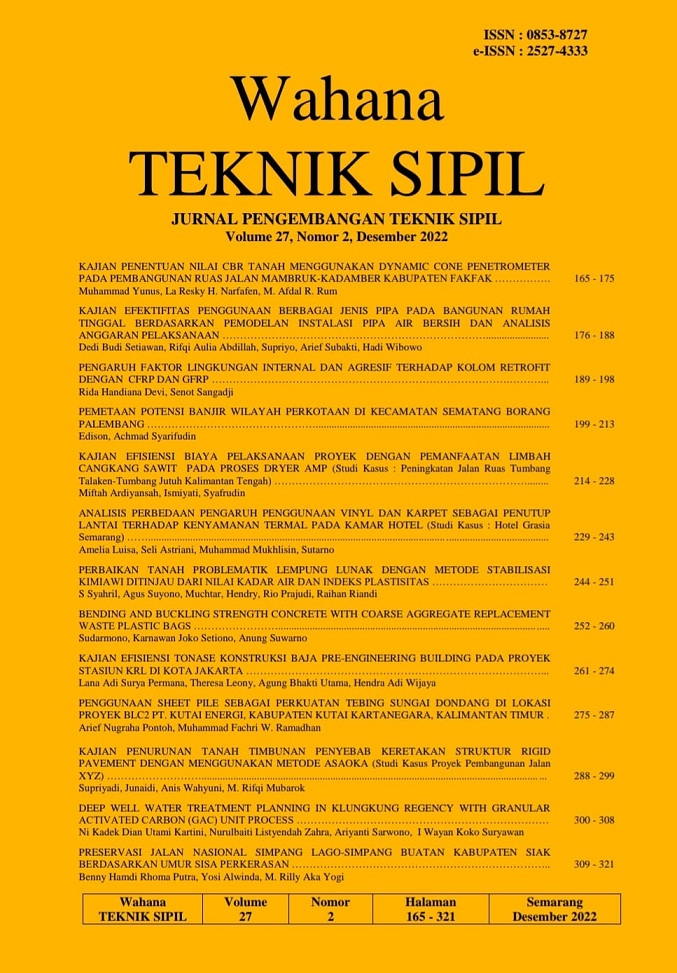BENDING AND BUCKLING STRENGTH CONCRETE WITH COARSE AGGREGATE REPLACEMENT WASTE PLASTIC BAGS
DOI:
https://doi.org/10.32497/wahanats.v27i2.4146Keywords:
Waste plastic bag, mix, flexural strength, buckling strength, reinforcement ratioAbstract
Mix concrete practical 1pc: 2 ps: 3split, people used to build houses, has a specific
gravity of 22-24 kN/m3. Density large concrete impact severity construction was,
blend ingredients lightweight aggregates to produce lightweight concrete. One is
used for lightweight aggregate material is waste plastic bags. Because the amount
of waste plastic bags or piled carelessly discarded in landfills (TPA) impact of
environmental pollution. This paper presents the study of the flexural strength and
buckling the use of waste plastic bags as a partial replacement of coarse aggregate
mix. The percentage of coarse aggregate replacement with waste plastic bag of
approximately 30% is expected to produce flexural strength and buckling optimum
reinforcement variation different. Bending beam size 10/15 cm length of 70 cm,
variations in the tested reinforcement bending strength. While buckling strength
using the dimensions of length 70 cm 10/10 with a variety of symmetrical and non
symmetrical reinforcement. Effective capacity reinforcement ratio press the tensile
reinforcement that generates maximum torque is 66.67%.
References
Buchanan, A.H., 1995, Fire Engineering Design Guide, Centre Advanced Engineering University of Centerbury, New Zealand.
Dradjad, K, Respati, S, Akhmad, J., 2010, Prototipe Beton Plastik dengan Bahan Dasar Agregat Plastik Hasil Daur Ulang, Poli Teknologi Jurnal Teknik Sipil Politeknik Negeri Jakarta, Jakarta.
Erwin, 2013, Pembuatan Beton Ringan Dari Aggregat Buatan Berbahan Plastik, Jurnal Gamma, Universitas Muhammadiyah Malang, Malang.
Pratikto, 2010, Beton Ringan Ber￾agregat Limbah Botol Plastik jenis PET (Polyethylene Terephthalate), Politeknik Negeri Jakarta, Jakarta.
Ramadhani S., 2011, Pemanfaatan Beton Styrofoam Ringan Untuk Fondasi Sumuran, Jurnal SMARTek, Universitas Tadulako, Palu.
Renilaili, 2013, Pemanfaatan Kemasan Plastik Bekas Dalam Campuran Beton Polimer, Jurnal Ilmiah TEKNO, Universitas Bina Darma, Palembang.
Rismayasari, Y., Utari, Santosa, U., 2012, Pembuatan Beton dengan Campuran Limbah Plastik dan Karakterisasinya, Indonesian Journal of Applied Physics, Fakultan MIPA, UNS, Surakarta.
Soebandono, B., Pujianto, A., Kurniawan, D., 2013, Perilaku Kuat Tekan dan Kuat Tarik Beton Campuran Limbah Plastik HDPE, Jurnal Ilmiah Semesta Teknika, UMY, Yogyakarta.
Sudarmono, dkk, 2015, Pemanfaatan Limbah Kantong Plastik Untuk Campuran Agregat Beton Sebagai Solusi Konstruksi Rumah Murah, Proseding, Sentrinov, Semarang.
Tjokrodimuljo, K., 2017, Teknologi Beton, KMTS FT UGM, Yogyakarta.
Zuraidah, S, Sudjatmiko, B., Salaudin, E., 2009, Peningkatan Kuat Lentur Pada Beton Dengan Penambahan Fiber Polyprophylene Dan Copper Slag (Terak Tembaga,Universitas Dr. Sutomo, Surabaya
Downloads
Published
Issue
Section
License
Authors who publish with this journal agree to the following terms:Authors retain copyright and grant the journal right of first publication with the work simultaneously licensed under a Creative Commons Attribution License that allows others to share the work with an acknowledgement of the work's authorship and initial publication in this journal.
Authors are able to enter into separate, additional contractual arrangements for the non-exclusive distribution of the journal's published version of the work (e.g., post it to an institutional repository or publish it in a book), with an acknowledgement of its initial publication in this journal.
Authors are permitted and encouraged to post their work online (e.g., in institutional repositories or on their website) prior to and during the submission process, as it can lead to productive exchanges, as well as earlier and greater citation of published work (See The Effect of Open Access).






